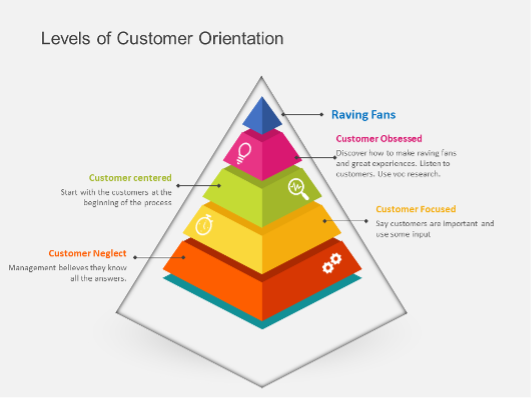This week we have another guest post from Alan Hale of CMG (Consight™ Marketing Group) in Chicago. Exceptionally, I am publishing it as two separate posts because its length and value deserve the detail and effort he has put into it.
I have been fortunate to have managed over 250 voice of the customer projects in B2B over the last four decades, with over 50 engagements on customer satisfaction and loyalty. These projects were across a wide variety of industries.
Which weight machines to develop the quadriceps? proper hack squat form hotel du palais (weight room / cardiotraining room), biarritz (64200) – pyrénées-atlantiques.
During this time, I have seen some great successes and some tragic failures in trying to make customers Raving Fans. Based on this experience, I wanted to share some best-in-class insights on how to make your existing customers Raving Fans.
According to industry research, acquiring a new customer is 5 to 7 times more costly than keeping your existing customers, which is why you need to concentrate on keeping your customers and making them Raving Fans. While customer acquisition is indeed important, so is holding on to your customers and making them Raving Fans.
There is a lot of information on the media and LinkedIn about customer acquisition such as website development, SEO, ad words, effective selling and phone calling etc. Very little has been written on keeping and serving existing customers. Other industry research states reasons why accounts churn. Very seldom is the reason for defection price, no matter what the sales reps tell you. It is a breakdown in account service, the account is not being serviced at a level of their expectations.
First, let’s define a Raving Fan. The term was coined by Ken Blanchard in a book called, Raving Fans published in 1993. A Raving Fan is a customer, who is excited about your product, service or solution. Think of Apple and Tesla. These companies have waiting lists for products and sometimes have long waiting lines for a new product. They are your brand advocates and are an extension of your brand. The characteristics of Raving Fans are as follows:
- They are less likely to churn to a competitor
- They are extremely loyal
- They will buy more i.e. you have a higher wallet share
- They are more likely to buy new products, services or solutions offered in the future
- They are usually (not always) less price-sensitive and therefore more profitable
- They may give insight on possible new products, services or solutions to introduce
- They may refer you to other friends and colleagues and/or provide testimonials
Most of this discussion is applicable to both B2C and B2B; with the exception of the 80/20 rule which is explained later. The following discusses the issues and hurdles in creating Raving Fans.
1. Senior Management Paradigms and Expectations. Senior management has two dangerous paradigms. The first paradigm is “we know what our customers want. After all we have been doing this for many years and are successful.” Yes, but the past does not equal the future. There may be new expectations from customers and prospects. Markets are not stagnant, there may be new technologies or new competitors. Don’t act like a film manufacturer who ignored the trend to digital photos since their profit was in the development of film and prints.
The second paradigm is that “we treat all our customers equally. We use the Golden Rule.” Although this works well in society, it is bad policy in business. In business, the smarter and more strategic companies use a modified Golden Rule, “He who has the gold rules.” You need to over serve these large customers.
There also needs to be a commitment from senior management to implement the results of this process. This is “walking the talk”. It is not something else to do when there is time; this is a major initiative. Hold people accountable and make sure the results are implemented across silos. As with all initiatives and establishing cultural norms, you need senior management buy in to succeed. Otherwise it will fail like so many initiatives.
The C-Suite must drive the desire for delighting customers and creating Raving Fans deep into the DNA of the organizational culture. The customer orientation pyramid is shown in the infographic below, which illustrates a spectrum of customer treatment with Raving Fans being the ultimate goal and True North compass.
 2. Validate your customer segmentation and value proposition. If these are not correct, it will be difficult if not impossible to create Raving Fans. For example, if you are selling a product with bundled service at a higher price point, and the company has its own technical support team internally, you will not be successful. If you have a brand new instrument but it is more difficult to use, you will likely fail. Ted Levitt a marketing professor in Harvard Business Review once said, “People do not buy drills. They buy holes”.
2. Validate your customer segmentation and value proposition. If these are not correct, it will be difficult if not impossible to create Raving Fans. For example, if you are selling a product with bundled service at a higher price point, and the company has its own technical support team internally, you will not be successful. If you have a brand new instrument but it is more difficult to use, you will likely fail. Ted Levitt a marketing professor in Harvard Business Review once said, “People do not buy drills. They buy holes”.
3. Under promise and over deliver. The majority of companies make promises and then fail to keep them; they over promise and under deliver. They should be under promising and over delivering. The job is to manage customer expectations as well as your performance. That means state a deadline you know you can easily meet, and then perform beating that promised time. This will set you apart from the competition.
There is a Chinese restaurant we order from for home delivery. When we call, they always say one hour. They consistently deliver within 25 to 30 minutes. One day I asked the owner why he does this. He said, “But aren’t you happy”? When you promise to call back or give a response on a price quote, emulate the Chinese owner and manage expectations and beat your deadlines.
4. Concentrate your effort by focusing on the 80/20 principle. In business to business, there is a rule that 20% of your accounts have 80% of your revenue. So if you have 1,000 active accounts, there are 200 accounts that your business depends on. Another way to look at it is if your number one account defects, how much trouble would your business be in? Answer: Strong negative impact. Concentrate on over-servicing these key accounts. ITW has been successful in growing its business by executing this principle.
Start by listing your accounts in descending order of revenue in a spreadsheet. When you hit 80% of your revenue, you have defined your top major accounts. These are your “Gold” accounts. Next add to these accounts, large accounts that have either walked away or have significantly decreased their purchases with you. Then, add to that any accounts which you legitimately feel – not just the salesperson’s opinion – can evolve into a large account. Then finally add key target prospects who might grow into large accounts. This is who you should be trying to understand insights as well as overserve.
Next, identify the stakeholders in each account, those who use the product or service, those who specify, and those who purchase. Usually, every key account has 2 to 3 or more key stakeholders. It could be the user, the specifier, and the person who purchases. For a plastic bottle manufacturer it was the packaging engineer, purchasing, and marketing.
5. Go out and visit. LISTEN. This I believe is the absolute fundamental foundation for creating Raving Fans. You need to obtain insight which is not delivered from web surveys. This is not done by using a 3 to 5 question set on how you performed after each interaction on IVR (Interactive Voice Response). Get off your chair, go talk to them. How are we doing? How do we compare to our competitors and your best-in-class vendors? What else should we be doing? Are we a partner? (Note: if your product is insignificant, they may not want a partnership.) The customer should be talking 80% of the time. Unfortunately, this is seldom done. In our opinion it is negligent to not call on customers to determine how you can improve.
Implement the 10, 30, 90 day rule. The most important thing you can do is visit and listen to your customers. Every 10 days, once every two weeks, the CMO, VP Marketing, VP Sales and Marketing or Marketing Director needs to visit key customers. This customer listening should be 10% of their time. Other functions like engineering, new product design, customer service and billing etc. needs to visit a customer every 30 days and talk and listen to their counterpart. Ask them what improvements can be made? What can we do to make you a Raving Fan?
Senior management has a responsibility as well. Customers love senior management calling on them. They feel appreciated, heard and valued. They want to know if the visions of the two companies are aligned? Will senior management direct resources to make it happen? We believe the highest value accounts, should each be assigned to a senior manager for quarterly dialogues. Then, go visit them and listen to them. Each member of the senior management team may have 2 to 3 accounts assigned to her or him.
6. Supplement these personal interviews with other Qualitative We call these diagnostic questions in order to diagnose the current health of the client relationship, diagnose root causes for unhappiness and prescribe the key things to work on. We are a strong believer in using qualitative VOC (Voice of the Customer) discovery research to obtain insights, to understand the why’s. This can be a combination of focus groups, in-depth phone interviews, personal interviews, ethnography, and other qualitative research methodology. I honestly do not understand the reluctance to use qualitative research.
Let’s talk about the pros and cons of web surveys. Pros include inexpensive to administer, quick to get feedback, and helps make the qualitative data more robust or even statistically significant. I have had numerous discussions about statistical significance. If you are surveying 80% of your sales in a B2B setting like 200 accounts out of 1000, you are not statistically significant on a pure number of accounts basis, but you are sampling 80% of your revenue. Which is more important? Of course, it is the 80% of sales. B2C service providers have a difficult time understanding this concept.
Web surveys are easy to fill out but do not provide the insight, and the why’s, with or without artificial intelligence. When you add qualitative questions to web surveys, a few things occur. First, very few respondents take the time to fill the information out. Second, they use two or three words with little elaboration. Sure web sites can count how many times responsive is mentioned, but if a respondent says they get back to me quickly, the association with the word responsiveness is not always picked up and categorized. And please stop telling me a word cloud is an insight. It is not. It is a picturesque way of showing the frequency of words cited.
When you do qualitative research, it is like peeling the onion to get to the issues that matter most. An example. What is your rating for our delivery? It is a 5 on a 10 scale. Why? The truck is late. Can you further explain? Yes, the truck misses the two-hour window. Why is that an issue? We have a small loading dock and lots of trucks. How can the client deal with this better? It would be great if they called when they are running late. This is called proactive communication.
There is a place for web surveys, but only after the qualitative is done, at least for B2B research. We actually like to use them as a way of collecting information from the non-key accounts. From a B2B perspective, spend the research dollars where it has the most impact – your largest accounts. In B2C with millions of customers, like bleach or toothpaste, it might make sense to start with quantitative to tease out opportunities where you then utilize qualitative research to dig deeper.
7. Use a mix of NPS (Net Promoter Score) and CSat (Customer Satisfaction). There has been a lot of bashing of NPS lately in magazines and posts in business social media, mainly claiming it is not actionable. Well if you use it wrongly, it won’t be actionable. I hear comments like we have a 27% NPS, now what do we do? Who knows? If you did not get the reasons behind it and how to improve, all you have is a number. If you try to use a hammer on wood screws, it won’t work. Don’t blame the tool. In our opinion, NPS is a great tool to have in the marketing toolbox.
NPS is very valuable because it measures the relationship using the personal risk of recommending. It measures the overall relationship and not a specific transaction. The NPS number is a benchmark as well as a check on your progress on improving the relationship over time. The real value is in determining the insights, and crafting actionable tactics and strategies FOR EACH KEY ACCOUNT that will drive the number up. We are a strong believer in NPS and have used it to predict accounts that will churn in the future as well as those who will buy a lot more in the near future.
These are the first seven keys to creating raving fans; the remaining 16 will be shared in Part 2 of this post, which will be published next week. Make a note to come back here to read it.












